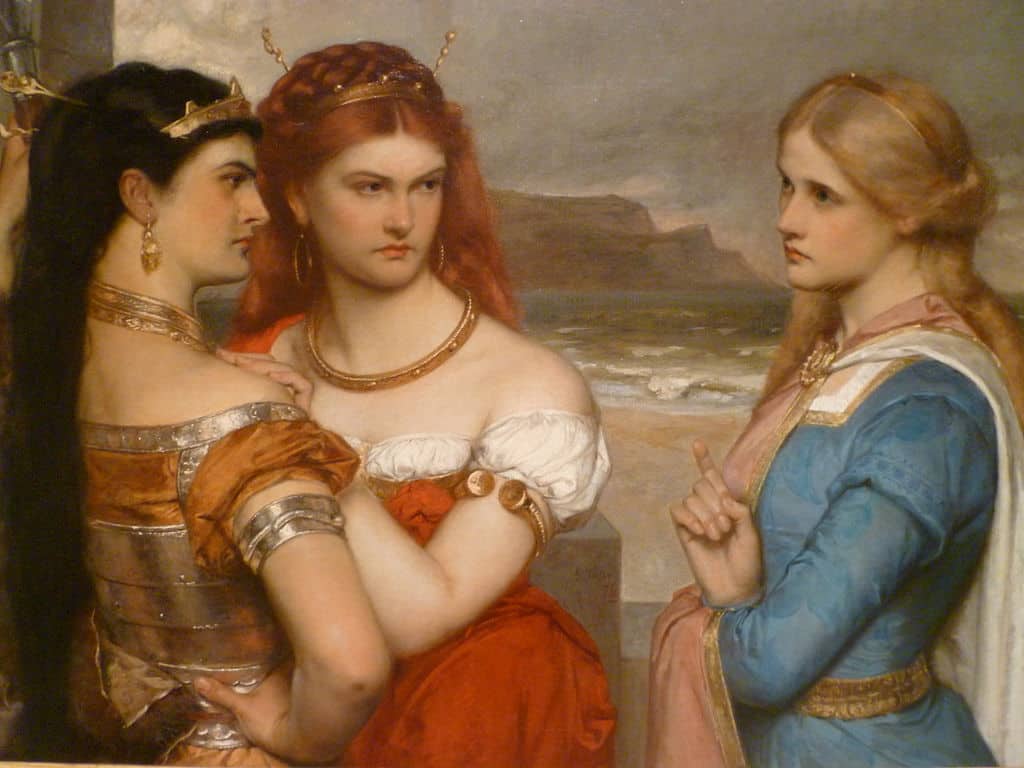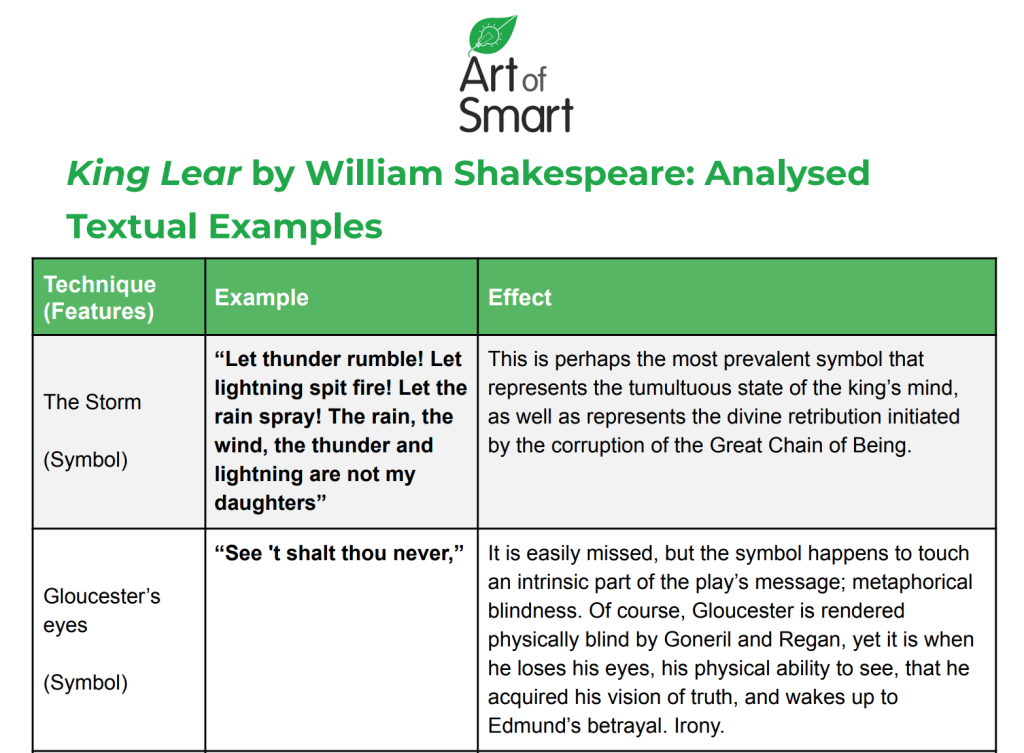Been studying Shakespeare’s ‘King Lear’ but aren’t sure where to start with your analysis of the text? Don’t stress — we’ll guide you through the themes, the key characters, context and provide you with a summary of King Lear to help you write an amazing essay.
We’ll also provide you with a sample analysis table (also called a TEE table) and an example of a paragraph that gets high marks for King Lear!
What are you waiting for? Let’s get started on crafting an analysis for King Lear!
King Lear Summary
Key Characters in King Lear
Context
Themes Explored in King Lear
Analysis of King Lear
Summary of King Lear
The old English King Lear looks to retire in old age, and divide his kingdom between his three daughters: Goneril and Regan, the older and ruthless sisters, and Cordelia, the youngest and most loyal. Lear, however, exiles Cordelia, who refuses to flatter him when responding to the King’s question: “Who loves me the most?”
Contrastingly, her sisters flatter Lear into giving the kingdom to them only. Against a stormy backdrop that impersonates the King’s confusion and blindness, Lear is forced to come to terms with his wrongful decision.
Kent, a returning loyal advisor in disguise, and the Fool, help Lear realise that Cordelia’s loyalty was much more precious than the falsehoods professed by Goneril and Regan. Cordelia, married off to the King of France, eventually returns to England with an army to defeat her older sisters.
Meanwhile Edmund, the devious and power-hungry illegitimate son of Gloucester (advisor to Lear), frames his older half-brother, Edgar, in a plot to kill their shared father. Gloucester falls to the deceit, Edgar goes into hiding as a beggar, and Edmund has affairs with both Goneril and Reagan to take their newly-inherited power.
After realising his mistake, Gloucester tries to oppose Edmund, but is tragically tortured and killed by the ruthless sisters. After defeating the French army, Edmund sends his henchmen to assassinate Cordelia and Lear, but is challenged by Edgar to a duel, in which he ultimately perishes.
Goneril then poisons Regan out of jealousy for her secret affair with Edmund, shortly before taking her own life after realising her mistakes. Lear is reunited with Cordelia in captivity, but she is tragically hanged by Edmund’s henchmen.
Lear cannot take this ultimate tragedy, and dies over Cordelia’s corpse. Upon Lear’s death, Edgar is crowned king.
Key Characters in King Lear
King Lear
This tragic hero undergoes a severe development throughout the play. Starting out as an invidious and attention-seeking king, crucially and metaphorically blind to love, King Lear becomes appreciative of love by the end of the play, too late, however, to save his daughters from death.
Lear is a complete character that benefits from all of Shakespeare’s life experiences.
The Fool
The fool acts as King Lear’s conscience, and there is debate as to whether he is a real character or just fruit of Lear’s imagination. The fool serves to strip away King Lear’s royalty, and reveal the king as just a begrudged old man.
The fool is perhaps one of the most important characters in the play, who mocks and drags Lear out of his blindness to love.
Gloucester
Gloucester acts as a parallel to Lear. He too is unable to recognise Edgar’s innocence, and falls for the plots of his illegitimate son Edmund.
He pays for it with his life, but not before realising his mistake and apologising to Edgar. Gloucester dies with a smile on his face between Edgar’s arms.
Edgar
The son of Gloucester, Edgar represents the moral right in the play. Hence why he succeeds Lear in his daughters’ stead, and the great chain of being is restored.
Although minor at the very beginning of the play, Edgar is instrumental in the final acts, where he fights his half brother (good VS evil) and he guides his father to the truth, albeit too late.
Edmund
As the polar opposite of Edgar, Edmund represents the clear villain of the play, a role shared with both Goneril and Regan. Edmund, however, isn’t completely corrupt.
Upon dying at the hand of his half brother, he realises his mistakes, and is redeemed in the eyes of the audience.
Goneril and Regan
Despite the two sisters being the main villains of the play, they possess redeeming qualities like love and affection, that redeem them as characters in the end. Something to consider is their craftiness and ambition, somewhat similar to Lady Macbeth, that was so unusual in female characters of Shakespeare’s competitors.
Shakespeare elevates Goneril and Regan to the point where they are able to best their wise father and snatch power from him.
Cordelia
Cordelia is a representation of truth, that serves more as a tool than a character, a tool to make Lear progress as a character and as a person. In fact, as Lear understands that truth is more important than pretty lies and flattery, Cordelia dies.
Kent
A loyal servant till the end, Kent’s end is somewhat ambiguous, although it is hinted at the end of the play that he may have followed Lear to his death.
Context of King Lear
William Shakespeare, a devout Protestant, wrote King Lear during the reign of the Catholic, Scottish King James I. James was despised in England, and King Lear’s blindness to the truth and lack of judgements are today acknowledged as an implicit parallel to the real life monarch.
King James I
There is no explicit reference to King James in the play, however, as this would have most likely gotten Shakespeare killed. The reign of King James I was much less glorious and successful than that of the late Queen Elizabeth I, the last Tudor, who reigned over England’s ‘Golden Age’ and made Shakespeare a knight.
Interestingly, Shakespeare is thought to have begun writing King Lear in 1605, the same year of the failed 5th of November Gunpowder Plot, an attempt to assassinate King James in Westminster. Today it is an important national holiday in England.
Analysis of Themes Explored in King Lear
If you are studying this text for QCE Literature, Unit 4 explores literature through the broad term ‘Independent Exploration’. This means you are free to interpret the text in whichever way you want, still maintaining and exploring complex ideas.
Here are some considerations to get you started…
Human blindness to the truth
Both King Lear and Gloucester are subject to deceit. In the beginning, Lear is too proud and vulnerable to flattery; so absorbed in himself, he fails to see that Cordelia loves him most, even though she cannot express this into words.
Gloucester blindly trusts Edmund without consulting Edgar, sealing thus his tragic destiny. A parallel is formed between Lear and Gloucester, who fall victim to their own lack of judgement.
Ironically, Gloucester sees the truth as his eyes are gouged out (as he loses his physical sight).
The challenge of authority
Although initiated by the King himself, the replacement of Lear with Goneril and Regan results in misfortunes and misery. Aside from the death of most major characters, Lear’s displacement results in a costly war between England and France, and ultimately a kingless kingdom.
Shakespeare uses pathetic fallacy to reinforce this: a violent storm rages for most of the play, signalling the divine anger at the usurpation of the throne. The playwright discourages audiences from wrongfully challenging authority.
The idea of the ‘Great Chain of Being’ and the ‘Divine Right’
A widely held belief at the time, it professed that the King was chosen by God to rule, and that therefore was only answerable to God, and not the Law.
All other living beings fell in a specific order, with nature being subordinate to humans, and humans being subordinate to their monarchs. Any disruption of this order was thought to result in terrible calamities.
The forfeiting of responsibility
Lear misjudges his daughters’ capability to handle power, and abdicates his responsibility as King. He is forced to pay dearly for this decision.
Shakespeare warns his audiences against abdicating their responsibility, particularly those who hold much of it. This can be definitely used as an implicit connection to King James I and his poor management of the country at the time.
These examples will end up underpinning your analytical essay. The analysis you will carry out will ultimately demonstrate some of these key ideas.
How to Analyse King Lear in 3 Steps
Step 1: Choose your example(s)
The best way to choose an example is to choose a technique. Remember you must include stylistic devices (how images and words are arranged in a text in order to produce meaning), and aesthetic features (elements that prompt a critical response from the reader) in your essays to gain the most marks.
The following quote incorporates symbolism and pathetic fallacy:
“Let thunder rumble! Let lightning spit fire! Let the rain spray! The rain, the wind, the thunder and lightning are not my daughters“
Step 2: Identify your techniques
In this case, Lear commands the heavens to strike their thunder and lightning. These natural phenomena are a symbol of divine retribution, as a result of the usurpation of the throne by Goneril and Regan, and the subsequent disruption of the Great Chain of Being.
We could say these natural occurrences are a manifestation of the Great Chain of Being in materiality.
Furthermore, the idea of pathetic fallacy comes into play when we consider that the storm may be mirroring the confused and enraged state of the King’s mind.
Step 3: Carry out your analysis
Always be ready to ask yourself what the author intended you to feel/respond emotionally by reading the example quote. This will make sure that you tackle an important part of the analysis, which is the effect on the reader.
William Shakespeare masterfully utilises both aesthetic and stylistic devices to convey King Lear’s grave error, that of abdication and misplacement of power from his hand to those of his evil daughters. He does this through the symbol of the storm: “Let thunder rumble! Let lightning spit fire! Let the rain spray! The rain, the wind, the thunder and lightning are not my daughters”.
For the complete analysis, download the paragraph below!
Need some help analysing other texts?
Check out other texts we’ve created guides for below:
- Mrs Dalloway
- The Great Gatsby
- Jane Eyre
- In Cold Blood
- Run Lola Run
- Amélie
- Shafana and Aunt Sarinnah
- Pride and Prejudice
- Jasper Jones
- One Flew Over the Cuckoo’s Nest
- Things Fall Apart
We’ve also got articles specifically on plays by Shakespeare which you can have a read through below:
Are you looking for some extra help with your analysis of King Lear?
We have an incredible team of English tutors and mentors!
We can help you master your analysis of King Lear by taking you through the summary, key characters and themes. We’ll also help you ace your upcoming English assessments with personalised lessons conducted one-on-one in your home or online!
We’ve supported over 8,000 students over the last 11 years, and on average our students score mark improvements of over 20%!
To find out more and get started with an inspirational English tutor and mentor, get in touch today or give us a ring on 1300 267 888!
Vittorio Manessi is an Art of Smart tutor based in Queensland studying environmental science. He was one of the first Year 12 students to study under the new ATAR system in Queensland. He enjoys Maths, Science, English and Ancient History and is keen to share his knowledge of the QCE by making awesome resources.






